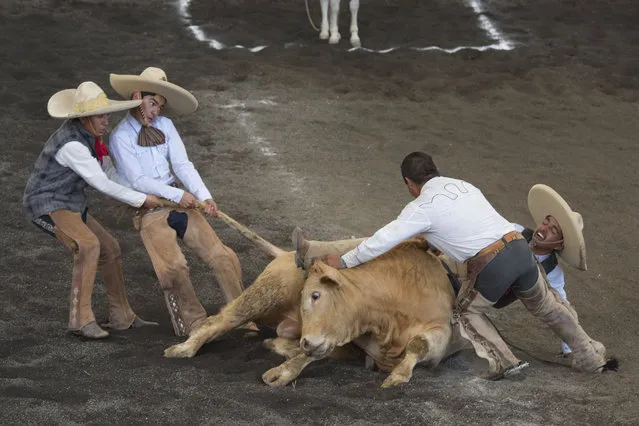
In this February 28, 2015 photo, teammates struggle to lift a bull off the trapped leg of a charro, during the bull riding event at a charreada in Mexico City. National Charros Association President Manuel Basurto Rojas said: “We in charreria are taking things into our own hands. We have codes, we have rules, for how to treat the animals. On the other hand, there is a lot of danger involved for the men doing these tricks”. (Photo by Rebecca Blackwell/AP Photo)
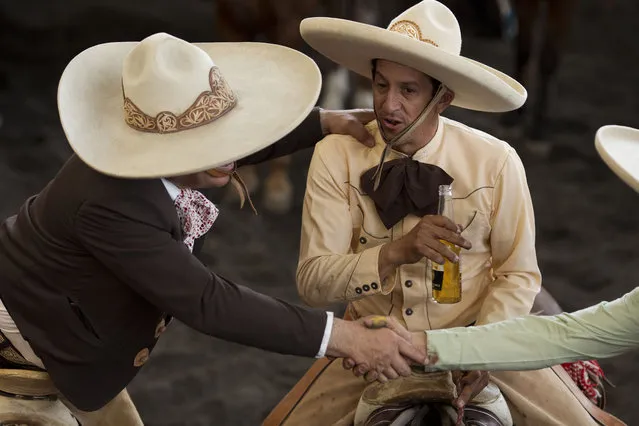
In this February 28, 2015 photo, charros drink and greet friends as they sit on horseback on the sidelines of a charreada in Mexico City. Although winning is always an honor, said Manuel Basurto Rojas, president of the National Charros Association, the main importance of the infrequent national competitions is really “social harmony”. “It's primarily a chance to spend time with all the brotherhood of charreria from the entire Mexican republic”. (Photo by Rebecca Blackwell/AP Photo)
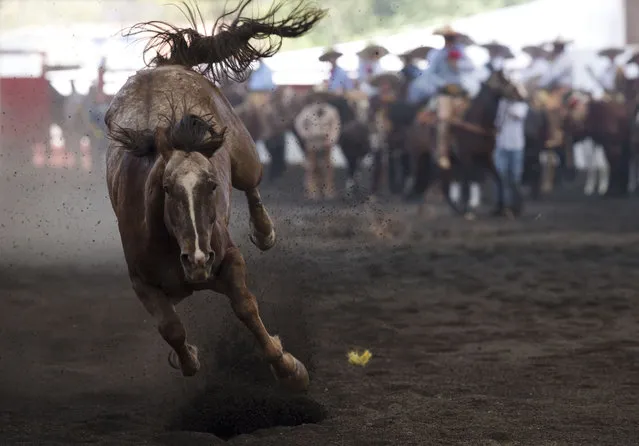
In this March 1, 2015 photo, a wild horse escapes a charro's lasso during the heeling event, in which a charro must catch the horse's back legs with his rope, at a charreada in Mexico City. National Charros Association President Manuel Basurto Rojas said the animals used for the events are treated and fed well “so that they can withstand”. While the Mexican government has recently enacted legislation to ban the use of animals in circuses, similar pressure has not been put on charreria. “Nothing has happened because we have a rule book on how to treat the animals”, said Basurto. (Photo by Rebecca Blackwell/AP Photo)
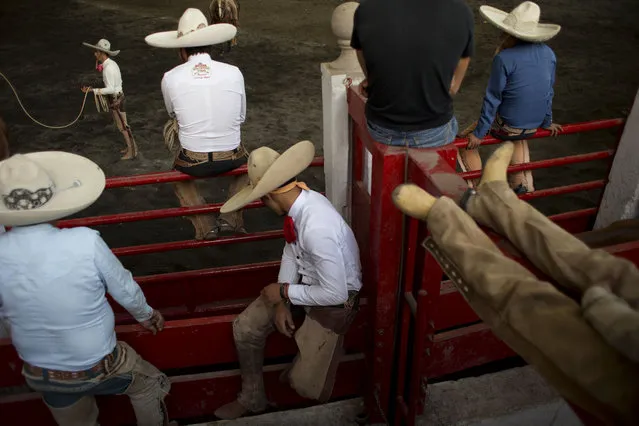
In this February 26, 2015 photo, young charros who participate in wild bull and horse riding, and roping events, watch the competition from atop animal pens, at the National Charros Association arena in Mexico City. Typically charros compete in club and association teams, and this “national charreria” brought together a selection of the top charros from each state. After an eight year gap, the fourth edition of the championship took place from February 26th to March 1, 2015, with teams from 27 Mexican states participating. (Photo by Rebecca Blackwell/AP Photo)
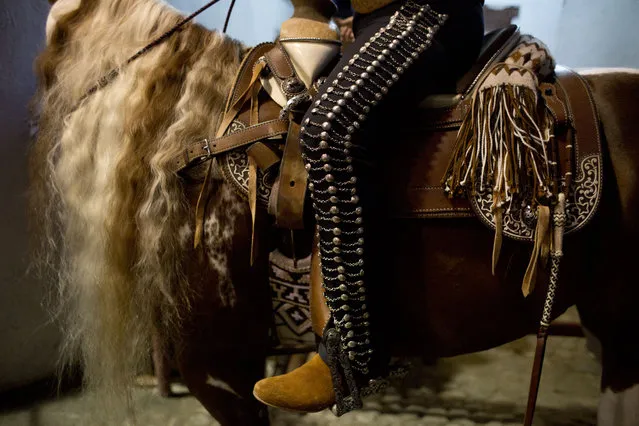
In this February 26, 2015 photo, a charro sits atop his horse as he waits to enter the arena, during a charreada in Mexico City. For National Association team member Fernando Armando Juarez Manzur, who began riding at age two and is now 40, being a charro is both a way of life and an identity. “When one dresses up as a charro in any part of the world, one knows you are a Mexican”. (Photo by Rebecca Blackwell/AP Photo)
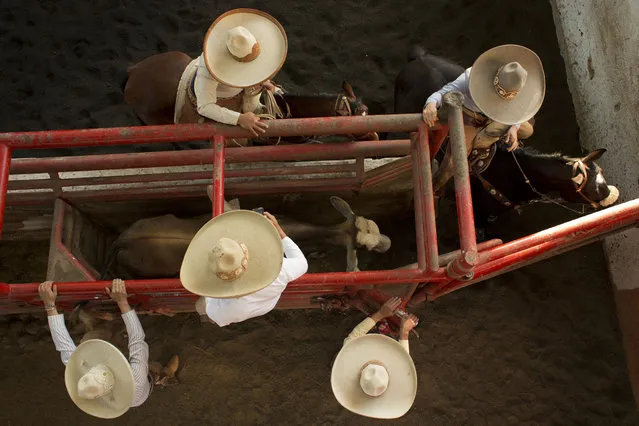
In this February 26, 2015 photo, charros prepare a wild bull to run, as a competitor, right, waits to grab the bull's tail and attempt to flip it, in the steer tailing event at a charreada in Mexico City. If a charro fails to grab the bull's tail as it exits the gate, it can be very difficult to capture it and flip it within the distance allowed. (Photo by Rebecca Blackwell/AP Photo)
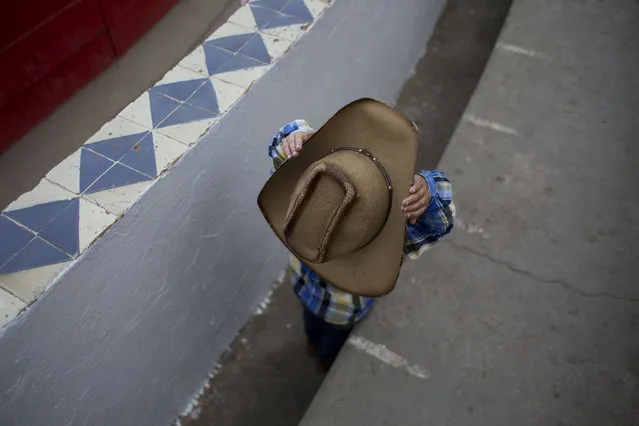
In this Feb. 26, 2015 photo, a boy adjusts his cowboy hat as he waits in the front row for the start of a charreada at the National Charros Association arena in Mexico City. Association member Fernando Medellin Leal, who has been participating in charreria for 30 years, says children from charro families are introduced to the sport as early as two or three. “The tradition of charreria is transmitted from grandparents to parents, from parents to sons. Working with horses begins at a very early age”. (Photo by Rebecca Blackwell/AP Photo)
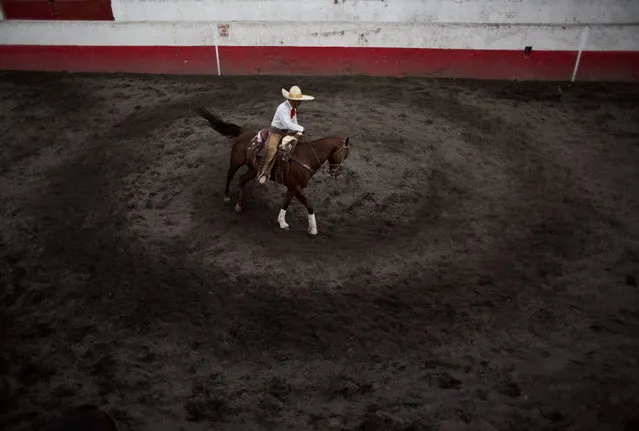
In this February 26, 2015 photo, a charro warms up his horse by practicing circles outside the arena during a charreada between teams composed of the best charros from 27 Mexican states in Mexico City. For competitive charros, the sport is an encompassing passion. To excel, they need to dedicate much of their free time to working with their horses and honing their skills in the different disciplines. (Photo by Rebecca Blackwell/AP Photo)
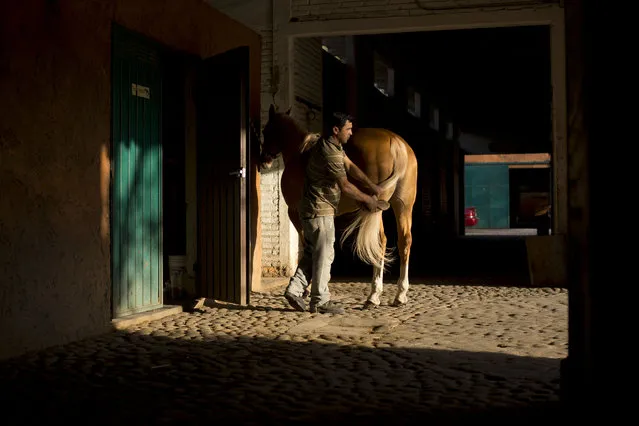
In this February 26, 2015 photo, a stable worker brushes out the tail of a freshly washed charreria horse, after competition, during a charreada in Mexico City. According to National Charros Association member Fernando Medellin Leal, people appreciate charreria because “it's something that identifies us as Mexicans. People enjoy this party because it keeps traditions and cultural values alive such as strength, work, order and respect”. (Photo by Rebecca Blackwell/AP Photo)
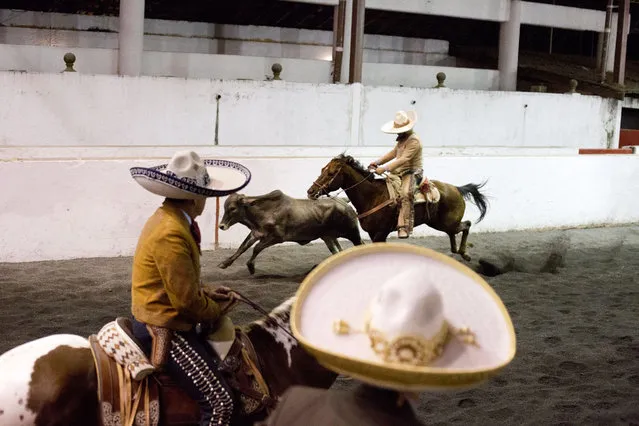
In this February 26, 2015 photo, charros watch from the sidelines as another charro tries to loop the tail of a running bull around his leg in order to bring it down, during a steer tailing event at a charreada in Mexico City. Riders score points depending on how quickly they can bring down the bull, and additional points are awarded if it rolls after falling. (Photo by Rebecca Blackwell/AP Photo)
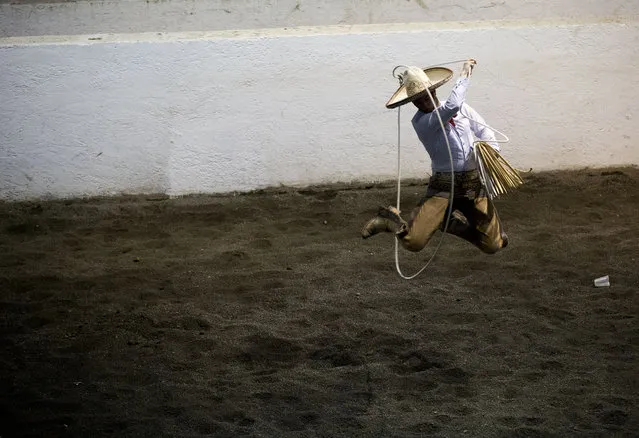
In this February 26, 2015 photo, Charro Carlos Maurer, from Puebla, practices his lasso skills ahead of the roping events, during a charreada in Mexico City. In team roping, charros must lasso both the neck and the hind legs of a bull, while in horse roping a charro on foot must capture a wild horse by roping its front legs. Extra points are awarded for rope tricks. (Photo by Rebecca Blackwell/AP Photo)
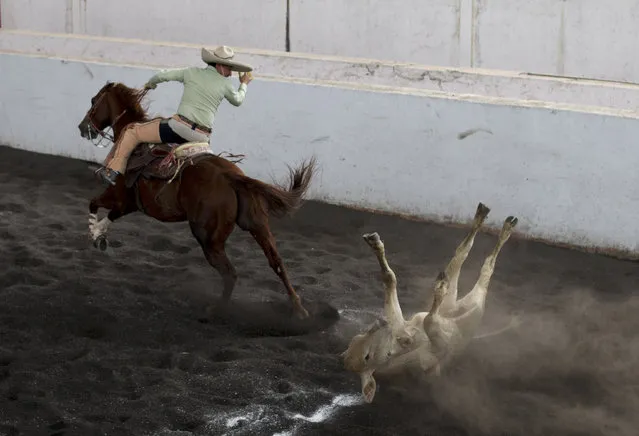
In this February 28, 2015 photo, a charro looks over his shoulder to see a bull roll after he succeeded in flipping it by its tail as he competes in the steer tailing event at a charreada in Mexico City. Teacher Maria Eugenia Bravo, who was in the sparsely filled stands to watch the charreria competition, said: “The problem is that this is forgotten, and there should be more publicity so that more people can come and watch these events”, referring to Mexico's national sport. (Photo by Rebecca Blackwell/AP Photo)
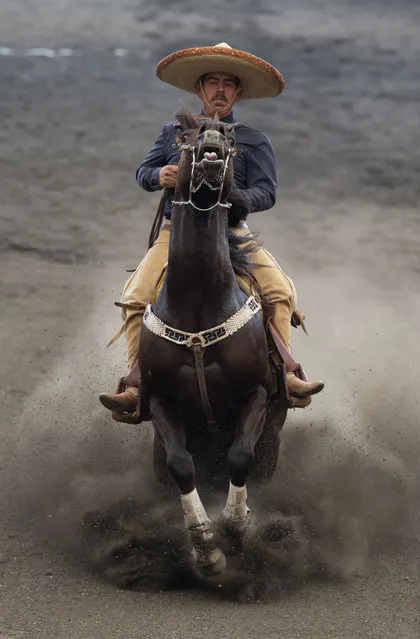
In this March 1, 2015 photo, a charro reins his horse to bring it to a sliding stop from a gallop, during the reining event in which a rider is judged on his horse control skills, including turning and stopping the horse on its hind legs and walking his horse backwards and sideways, during a charreada in Mexico City. “The pairing between a horse and a rider is like we were one piece”, said National Charros Association member Fernando Medellin Leal. “There is a total understanding”. (Photo by Rebecca Blackwell/AP Photo)
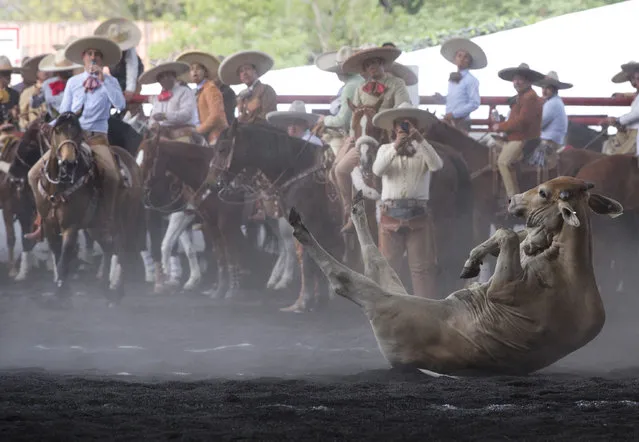
In this February 28, 2015 photo, charros look on as a bull rolls after being brought down in the steer tailing event at a charreada in Mexico City. In the U.S., animal rights groups have criticized some charreria sports, including steer tailing and horse roping, saying they could injure the bulls or wild mares. Charro Fernando Medellin Leal says, “There may be an accident and the rider could be harmed or the animal could be harmed. But what we are looking for is that everything is done with technique, so that the animals are not harmed. We are not under any circumstance intending to mistreat or hurt the bulls”. (Photo by Rebecca Blackwell/AP Photo)
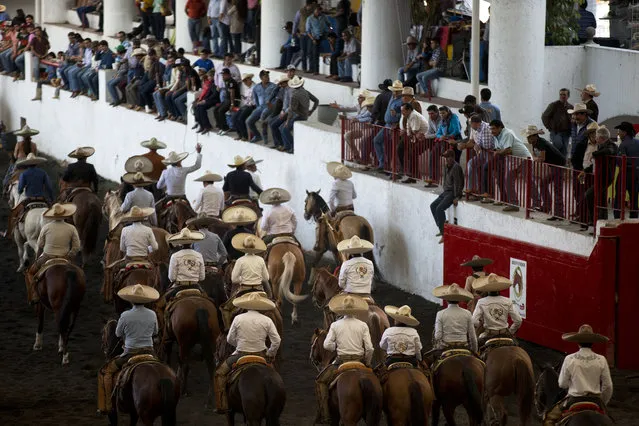
In this February 26, 2015 photo, teams ride in procession out of the ring after the opening of a charreada in Mexico City. “The future of the charreria”, said National Charros Association President Manuel Basurto Rojas, “is to educate the entire population so that everyone knows what our roots are. With horses, the [Spanish] conquest was done, independence was won, the revolution was made. It's part of Mexican identity”. (Photo by Rebecca Blackwell/AP Photo)
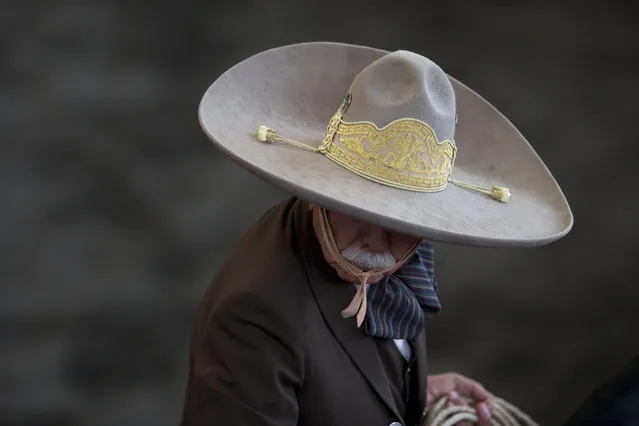
In this February 28, 2015 photo, a charro rides in the arena at the start of a roping event, during a charreada in Mexico City. Charreria is a sport that brings together enthusiasts and competitors of all ages. Charro Francisco Armando Juarez Manzur, 40, who was competing with the Nacional Charros Association team, said he's seen charros as old as 92 riding. But, he says, “There are some tricks like bull riding, the pass of death, and wild mare riding, that are generally for someone younger, because the blows are very hard”. (Photo by Rebecca Blackwell/AP Photo)
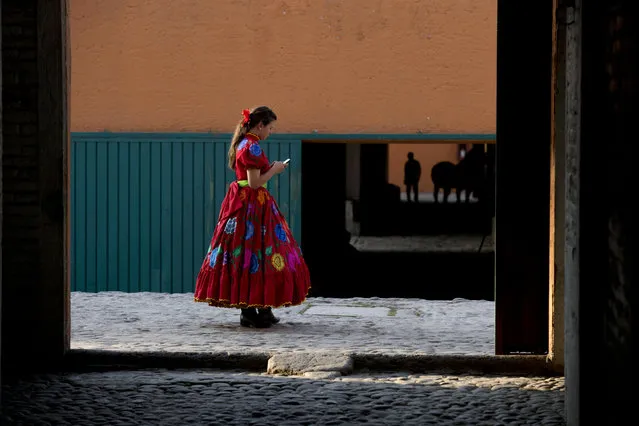
In this February 26, 2015 photo, a female charra, known as an Amazona and member of an escaramuza, pauses to check her phone near stable buildings at the National Charros Association during a charreada in Mexico City. Escaramuza teams, which gave skill demonstrations at the charreada, hold their own regular competitions in which they are scored for the ability to bring their horses to a quick stop and for the execution of synchronized precision riding formations, including spins, crosses, and side-by-side cantering. Unlike charros, escaramuzas ride side saddle. (Photo by Rebecca Blackwell/AP Photo)
15 Mar 2015 06:44:00,
post received
0 comments
